On other pages of this issue of “Franciscan Missions” will be found an article on the beauties and resources of the Pecos Valley, written by one who, from many years’ residence in this garden spot of the new state, is well acquainted with the country and its people, and it is not the object of this article to enlarge upon what has been said of Roswell and its surroundings, but to speak of the work the Fathers have been doing in this part of the Lord’s vineyard for the past eleven years.
New Mexico can justly be styled the kingdom of St. Francis, for the humble sons of this great saint were the first and only missionaries to bring the glad tidings of the Gospel to the Indians of this state. We need not recount the glorious success of their untiring labors in bringing about of Santa Fe, the Fathers of the Cincinnati their civilization till adverse circumstances forced them to leave their beloved red children and leave the work begun to others. New Mexico, however, was again to behold the brethren of the saintly Padres in their humble brown robe, going from town to town to continue the work the first Franciscans had begun. In June, 1900, upon the invitation of the Most Rev. Peter Boursrade, Archbishop of Santa Fe, the fathers of the Cincinnati Province took charge of the parish of Pena Blanca and its missions, and since then many other parishes have been confided to their care. The first issue of this magazine related the work our Fathers have been doing in the parishes of the northern part of the state where the population consists mostly of Indians and Mexicans; nothing, however, was said of the Missions of the southeastern part of New Mexico, of the beautiful Pecos Valley, where the Fathers have charge of Curry, Roosevelt, Chaves and Eddy Counties.
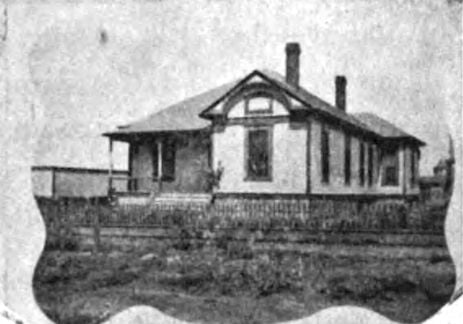
Pastoral Residence
Roswell, the metropolis of the Pecos Valley, is one of the most important cities of New Mexico, and, we may add, the most beautiful residential city in the whole state. Large school buildings and beautiful edifices have been erected in the past few years. The various denominations have their churches and have had them for years. The Catholics alone were without a church until 1903. Till then their spiritual wants were looked after by the Pastors of the Lincoln Parish who came occasionally to visit them. Among these may be mentioned the Rev. Fathers Migeon, at present at Tularosa, and Giraud, now stationed at Taos. Services were held in the county court house and in what is now called Chihuahuaita, also at the home of Cosine Sedillos on the Berrendos north of town. The number of Catholics grew steadily and soon the necessity of a resident priest was felt. The Most Rev. Peter Bourgade, Archbishop of Santa Fe, invited the Franciscan Fathers to take charge of this parish; and the Rev. Father Heribert Brockman, O. F. M., was appointed the first Pastor and Superior. The little band of missionaries, accompanied by the Very Rev. Raphael Hesse, O. F. M., arrived at Roswell in April, 1903, and immediately began organizing a parish. After due consideration it was deemed advisable to organize two parishes, one for the English speaking people and the other for the Mexicans.
Whilst there were about 125 Mexican families and about 100 single Mexican people, amply enough to organize a parish, there were very few American Catholics at Roswell; in fact, when the Right Rev. J. B. Pitaval, D. D., Auxiliary to the Archbishop of Santa Fe, came to Roswell the first time, no one seemed to know of any American Catholic families. Eventually 4 Catholic families and 10 or 12 Catholic single persons were found, not much material to organize with. The first Sunday Mass was said for the Americans, only 7 persons were present. At first, Mass was said in the bottling works, and, after a chapel had been built for the Mexicans, this was utilized also for the Americans. A beautiful location for the American church and residence was secured on South Main Street, most of the ground having been donated by a Non-Catholic. The Non-Catholics were very anxious to have a Sisters’ hospital.
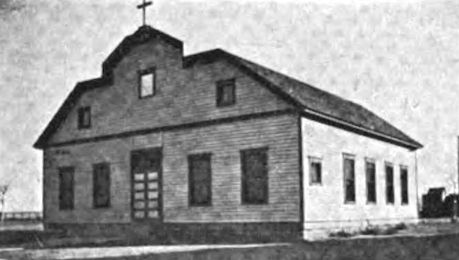
Roswell Parochial School
They not only donated most of the grounds for church and residence and school and hospital, selling the balance needed at about half price, but also contributed about $5000 to the building of the hospital and a fair sum towards the building of the Fathers’ residence and the basement church, dedicated to St. Peter, which was to serve as a foundation for a large, substantial church. Encouraged by the generous donation of $600 by a good Catholic member of his parish for a Catholic school, the Rev. Pastor erected a school building and employed a lay teacher. For the hospital, (St. Mary’s Hospital) he secured the Sisters of the Sorrowful Mother. At present writing the hospital numbers 26 Sisters and 310 patients.
Remembering the small number of Catholics, the lack of all resources, except a cheerful optimism, an unabating enthusiasm and an indefatigable zeal on the part of the Rev. Pastor, too much credit cannot be given to the splendid pioneer work of Father Heribert in conjuring into existence, as if by enchantment, the magnificent hospital, the pastoral residence, the beginning of a large church and, last but not least, the parochial school.
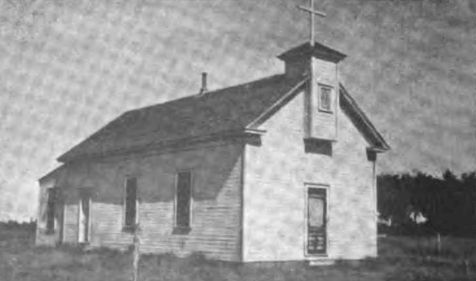
Church at Hagerman
His worthy successor, the Reverend Adalbert Rolfes, O. F. M., has enlarged the school and secured the Poor Sisters of St. Francis Seraph of Lafayette, Ind., who, 4 in number, have an enrolment of 85 pupils. He has paid off the parish debts, raised funds for the building of the new church and is making strenuous efforts towards the erection of a church edifice worthy of the metropolis of the Pecos Valley. The Catholic population of Roswell has more than trebled, numbering about 50 families.
From the very beginning the activities of the Fathers were not confined to Roswell, but embraced the counties of Chaves, Eddy, Curry and Roosevelt, 20,002 square miles. They visited Carlsbad, now an independent parish, at first once, afterwards twice a month. Then as now they attended to the Mission Stations of these extensive counties. The zealous Father Sixtus, who at present attends to these Missions from Roswell, jotted down the following items: “My Missions are five in number: Hagerman, Elida, Portales, Clovis and Melrose. I visit Hagerman on the first Sunday of every month, and at this place there are 7 Catholic families, about 30 members. They receive catechetical instructions at every visit. At Elida, my parish of the plains, I say Mass in a dugout on Tuesdays after the second Sunday; the homes of some of my parishioners are about 10 miles from town. Here I have 5 families of about 12 members. At Portales I say Mass once every month and on such week days as is convenient for me. Here there are 3 families of about 12 members. At Clovis I say Mass on the second, fourth and fifth Sundays and on the Mondays following these Sundays. Here I have 32 families of about 125 members. Here instructions are given every Saturday, either by myself or by a lay person. At Melrose I say Mass on the third Sunday of the month, not in a church, for I have none, but in a room of the First National Bank of Melrose. Here I have 5 families and a few single persons, about 20 members in all. This gives me a trip of between 765 and 1100 miles a month.”
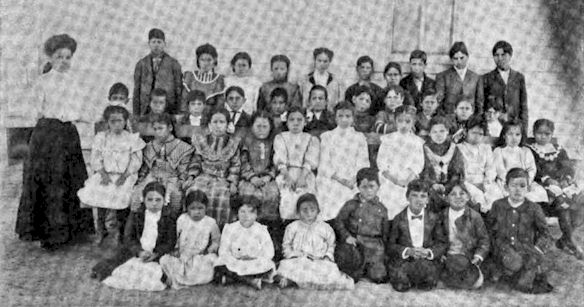
Mexican School Children
To revert to the Mexicans of Roswell, in the very beginning, i.e. in May, 1903, the Rev. Eligius Kunkel, O. F. M., was placed in charge of this parish. He built a chapel, dedicated to St. John the Baptist, in the southeastern part of the town near the suburb of Chihuahua, a Mexican settlement, and worked very zealously to organize the scattered Mexican people into a parish. He also opened a school in the chapel with Miss Christina R. Hernandez as teacher. In August, 1904, Father Eligius was succeeded by Father Robert Kalt, who labored faithfully for two years and furnished the chapel with the necessary vestments and appurtenances. When Father Robert was called to Carlsbad, to take charge of St. Edward’s and St. Joseph’s churches, he received a worthy successor in Father Theodore Stephan, who had been laboring for several years in the missions of the Peña Blanca parish where he had become acquainted with the habits and customs of the Mexican people. When Father Theodore took charge of the parish there was still a debt on the chapel, but the good Father not only cleared the debt, but also added a tower and a sacristy to the church and furnished it with an altar, organ and benches. Father Theodore foresaw that a new church would soon be needed as the chapel could not accommodate a parish of 150 families. He began collecting funds and had $600 on hand when, in January, 1911, he was called to Saint Michaels, Arizona. Father Turibius Christman, 0. F. M., till then in charge of the Missions of Curry, Roosevelt and Chaves Counties, was appointed to succeed Father Theodore. Seeing how necessary a new church was, Father Turibius began collecting funds for that purpose. Two societies were organized, one for the first Holy Mass in the new church, men, the other for the ladies of the parish, and thus the people were interested in the work and assisted their pastor in the noble and grand undertaking. With the help of various friends a neat sum had been gathered and work on the new building was begun July 8th, 1912, and at Christmas work had progressed far enough to permit the celebration of though neither floor nor ceiling, nor plastering nor pews graced its interior. Again kind friends came to our assistance, and in April, 1913, the church was
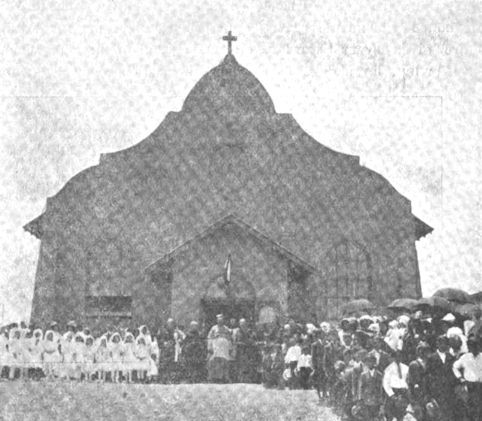
St. John Church
ready for dedication. His Grace, the Most Rev. J. B. Pitaval, D. D., Archbishop of Santa Fe, signified his intention to dedicate the new church, and accordingly plans were made to make this the greatest day in the history of Saint John’s parish. April 27, the feast of the dedication of the Basilica of Assisi and of St. Turibius, Archbishop of Lima, was the day set for the grand celebration. The day was a beautiful one. Bright and early the good Mexican people could be seen wending their steps toward their new church. At 9.30 A. M. a grand procession, led by men on horseback, left the building to meet his Grace and the Rev. Clergy at the parsonage of St. Peter’s on Main St. Meeting the Archbishop at St. Peter’s church, the children greeted him with an address in Spanish and presented him with a beautiful bouquet of pure white carnations. Escorting His Grace and the Rev. Clergy, the procession, joined by the members of St. Peter’s church, returned and, immediately after its arrival, the dedication ceremonies began. His Grace, the Archbishop, was assisted by the Rev. Fathers Jerome Hesse, of Peña Blanca, and Sixtus Kopp, of Roswell, as deacon and sub-deacon, Father Turibius Christman, the pastor, acting as master of ceremonies. The dedication was followed by a solemn High Mass coram Archiepiscopo. Our Very Rev. Father Provincial, Eugene Buttermann, O. F. M., was celebrant, Father Florian Briede, of Carlsbad, was assistant priest, Fathers Jerome Hesse and Sixtus Kopp acted as deacon and sub-deacon of the Mass, whilst Father Turibius Christman was master of ceremonies. The Archbishop occupied the throne on the Gospel side of the sanctuary and was assisted by the Rev. Anselm Weber, O. F. M., of St. Michaels, Arizona, and Father Celestine Matz of Carlsbad. Father Adalbert, Pastor of St. Peter’s Church, was present in the sanctuary. The sermons in English and Spanish were preached by the Archbishop himself. In the afternoon, at 4 o’clock, solemn Benediction of the Blessed Sacrament was given by Father Anselm Weber, after which the Archbishop confirmed 130 children. It may be of interest to our readers to know that it is a custom among Mexicans to have even little babies confirmed, though they be only a few months old.
The Mexican people of Roswell can justly be proud of their new church. When finished, it will be one of the most beautiful churches in the state. There is however a debt to be paid off before we can think of building a steeple and finishing the interior of the church, and, the people being poor, we must depend upon outside help. Good friends have assisted us in the past and we hope they will not abandon us in the future.
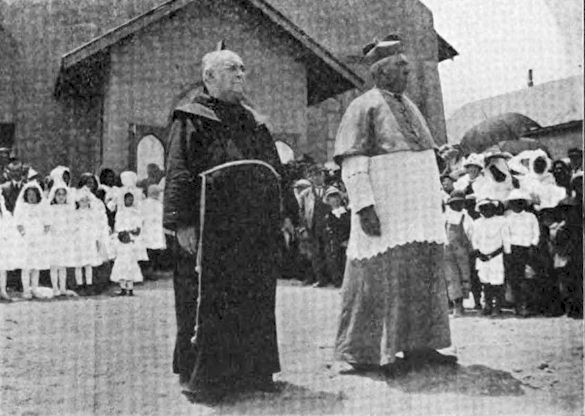
Visiting Archbishop and Provincial
Now a word about our Mexicans. Our Mexican population of Roswell consists largely of Mexicans of old Mexico who have come to the Pecos Valley from Texas. There are, however, also families from New Mexico, from the western part of the state. Our people have three settlements: Chihuahua in the southeastern part of the city, Saragossa in the southwestern part, and “Rag Town”, or La Garra in the northwestern part. La Garra and Saragossa are inhabited mainly by people who have come from the western part of the state, from Lincoln, Guadalupe and Torrence Counties, whilst Chihuahua is the home of those from old Mexico. Having come from different states of Mexico, they brought with them the different customs of those states. The marriage customs, however, are the same with all of them. If a young man wishes to marry a young lady, he must ask for the girl in writing and the parents are expected to answer within a week. The letter is to be written by the father, mother or older brother of the prospective groom, yes, very often even the Padre has the honor of writing this letter. The marriage ceremony in church is about the same as with our American people with the exception of the “arrhas” and the “velatio”. The “arrhas” usually consist of 13 pieces of money (dimes), which the groom places in the hands of the bride after he has given her the ring. After the ceremony at the altar the “velatio” takes place. A cloth, usually decorated with colored flowers, is placed on the shoulder of the groom and over the head of the bride, signifying that the husband is the head of the family. Then the hands of the bride and groom are tied with a cincture to remind them that they cannot break the bonds of matrimony and that they must live together until death.
At the funeral of a child there must be music. The instruments used are, as a rule, violin, guitar, mandolin banjo. Some time ago a funeral was announced for Sunday morning after Mass. At about 11 o’clock a little Mexican boy entered the sacristy and told the Padre that a parade was coming toward the church. A large procession of children in white, with flowers and wreaths, marched behind musicians leading the procession; then came four ladies carrying something; what it was could not be discerned at that distance. We saw that the young ladies were carrying the corpse of a child about two years old, seated on a rocking-chair, whilst a man, carrying the empty coffin, walked behind the young ladies. In church they placed the chair in the aisle and the coffin on the floor. After the blessing of the corpse all the women present kissed the child “adios”, and then the “madrina” (godmother) placed the corpse into the coffin, closed it and carried it out. Many of the Mexicans, beholding this spectacle could not refrain from saying: “Que Costumbre!” What a custom!
Very few of our Mexicans speak English, though they especially the younger generation, have had the opportunity to learn it. We have our own little parochial school were English and Spanish is taught. This year we have 75 on our enrolment list and we would have a larger attendance if we only had the room. Our school, the former chapel, measures only 20 x 40 feet. A larger school is necessary, but where are we to get the money to build it? Our people are to poor to support a school. We hope, however, to be able in the near future to commence the building of a school, large enough to accommodate all our children.
Source: The Franciscan Missions of the Southwest, Published annually by the Franciscan Fathers at Saint Michaels, Arizona, 1917.
